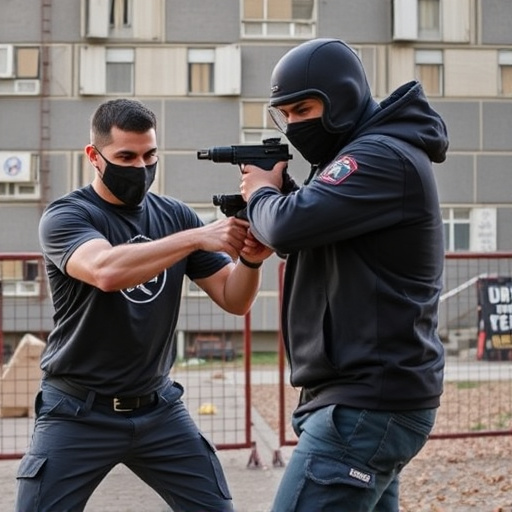Understanding Stun Gun Muscle Incapitation: Duration and Legal Aspects
The most powerful legal stun weapons disable individuals through rapid muscle depolarization, with i…….
The most powerful legal stun weapons disable individuals through rapid muscle depolarization, with incapacitation durations ranging from seconds to minutes. Global regulations vary widely, balancing personal safety and public concern. Device power, measured in joules, current type, contact area, and environmental conditions impact effectiveness. While stun guns offer crucial self-defense, myths about their immobilizing effects need clarification. Realistic expectations require understanding that duration varies based on device power, target characteristics, weather, clothing, and attacker movement.
In today’s world, understanding the duration of muscle incapacitation from stun guns is crucial for both personal safety and legal considerations. This comprehensive guide delves into the science behind these powerful legal self-defense tools, exploring what happens to your body during a stun. We’ll navigate legal frameworks governing their use, decode factors influencing inactivation duration, analyze real-world applications, and debunk myths surrounding their effectiveness. Discover the truth about the most powerful legal stun weapons and gain insights into their capabilities.
- Understanding Muscle Incapitation: What Happens When You're Stun-Ed?
- Legal Considerations: The Regulatory Framework for Stun Guns
- Decoding Stun Gun Power: Factors Influencing Inactivation Duration
- Real-World Applications: How Long Does Disability Last in Different Scenarios?
- Safety and Effectiveness: Myths vs. Facts About Stun Gun Immobilization
Understanding Muscle Incapitation: What Happens When You're Stun-Ed?
When a person is stunned by one of the most powerful legal stun weapons, their muscular system experiences rapid and intense depolarization. This sudden electrical disruption prevents the muscles from contracting normally, leading to temporary incapacitation. The duration of this muscle incapacitation varies based on factors such as the stun weapon’s output, the area targeted, and the individual’s physical condition.
Stun guns disrupt nerve signals traveling to and from the muscles, causing a brief but powerful paralysis. This disruption can last from several seconds to up to 15 minutes or more with high-voltage devices. During this period, the person becomes immobile, offering an opportunity for officers to secure the scene or gain control. Understanding these effects is crucial in understanding how stun weapons work and their legal implications.
Legal Considerations: The Regulatory Framework for Stun Guns
The regulation of stun guns, or electroshock weapons, varies significantly across jurisdictions, reflecting complex legal considerations surrounding their use and accessibility. While some countries have strict controls in place, limiting their availability to law enforcement agencies only, others have more permissive regulations allowing private citizens to own these devices. The most powerful legal stun weapons often fall under the category of personal protection tools, marketed towards individuals seeking self-defense options against potential threats.
Regulatory frameworks typically outline specific criteria for ownership and usage, including age restrictions, requirement for permits or licenses, and guidelines on permissible uses. These laws aim to balance personal safety concerns with public safety considerations, ensuring that stun guns are not used in a manner that could cause excessive harm or be exploited for malicious purposes. Understanding the legal landscape surrounding stun guns is essential for both users and law enforcement, as it dictates how these powerful tools can be employed within the boundaries of the law.
Decoding Stun Gun Power: Factors Influencing Inactivation Duration
Decoding Stun Gun Power: Factors Influencing Inactivation Duration
The effectiveness and duration of muscle incapacitation from a stun gun depend on various factors, which help determine its overall power. Among the key variables is the energy output, measured in joules, which represents the force delivered by the device. Higher joule ratings indicate greater stun capacity, making them among the most powerful legal stun weapons available.
Other considerations include the type of current used—AC or DC—and the contact area where the electrical discharge occurs. Narrower contact points can concentrate the shock, enhancing its impact but potentially reducing the overall duration of incapacitation. Additionally, environmental conditions like temperature and moisture can influence the device’s performance, as these factors affect electrical conductivity and muscle response.
Real-World Applications: How Long Does Disability Last in Different Scenarios?
In real-world applications, understanding the duration of muscle incapacitation from stun guns is crucial for both individuals seeking self-defense and law enforcement professionals. The effectiveness of a stun gun largely depends on its power output and the specific design, making some models more powerful legal stun weapons than others. Studies indicate that a well-administered shock from a quality stun device can render a target immobile for several minutes, providing an essential window of opportunity for escape or intervention.
Different scenarios yield varying durations of disability. In outdoor settings, the impact may last 3-5 minutes, allowing users to flee and create distance from potential threats. Indoor environments with enclosed spaces could result in slightly longer incapacitation times, up to 7 minutes, due to reduced air circulation. Factors like target size, physical condition, and clothing can also influence the duration of muscle paralysis, emphasizing the need for proper training when employing stun guns as a last resort for self-defense.
Safety and Effectiveness: Myths vs. Facts About Stun Gun Immobilization

Stun guns have often been a subject of myth and misinformation, especially regarding their effectiveness in incapacitating individuals. Many believe that a single shock from a stun gun will leave an attacker completely immobilized for an extended period. However, the reality is far more nuanced. The duration of muscle incapacitation varies based on several factors, including the power of the stun device, the target’s physical condition, and their tolerance to pain.
While stun guns are indeed powerful legal weapons designed to disrupt an attacker’s motor functions temporarily, the ‘immobilization’ is not always as dramatic or prolonged as advertised. The most advanced and most powerful legal stun weapons on the market can deliver a jolt that disrupts muscle control for 10-15 seconds, but this is under ideal conditions. Factors like weather, the attacker’s clothing, and their ability to move or block the shock can significantly reduce the effectiveness and duration of immobilization. Thus, while stun guns offer a crucial self-defense tool, understanding their limitations is essential for realistic expectations in high-stress situations.
In conclusion, understanding the duration of muscle incapacitation from stun guns is crucial for both users and authorities. As we’ve explored through various scenarios and real-world applications, the inactivation time can vary significantly based on factors like stun gun power and the individual’s physical condition. Among the most powerful legal stun weapons available, regulation plays a vital role in ensuring their safe use. Debunking myths about their effectiveness and safety is essential for fostering informed public discourse. By navigating the legal framework and leveraging scientific insights, we can harness these tools responsibly while safeguarding communities.


